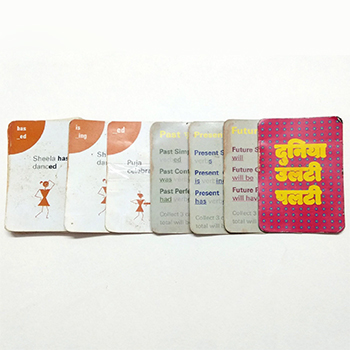A traditional classroom environment doesn’t provide much scope for teachers to try different ways of teaching. The population of students and the lack of availability of designed materials that would work for both teachers and students are two of the major constraints. When it comes to learning a second language (SL), the situation is even worse. The project "Can game-play aid structural understanding of language?" aims at facilitating ways of learning and teaching structural English (grammar) in a traditional classroom environment, where English is a second language.
The topic chosen in the grammar teaching is tenses, and the idea is to design a pedagogy that works for both teachers and students. The developed method (pedagogy) begins with a card game that facilitates pattern learning within tenses.
This is followed by a classroom activity designed to reinforce the acquired pattern. The third and final part of the design is a planned lesson (instructional design) to communicate the meaning of the overall concept.
A series of experiments were conducted with a group of 18 students in grades 6 and 7, and the designed materials were tested, improved, and then evaluated on the basis of the qualitative results of those experiments. The report further contains a detailed view of the testing with materials and their iterations. The results show an increase in the level of engagement of the students with the topic. It also indicates a jump in the quality of their ability to look for and find patterns in the materials given to them.
This project expands the boundaries of the ongoing LETS (Learn English Through Stories) project under the Tata Centre for Technology and Design, using games and planned lessons to teach structural English, thereby making grammar learning intuitive and fun.







